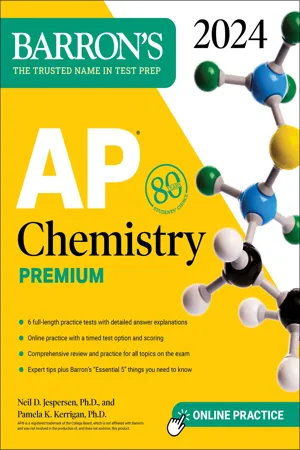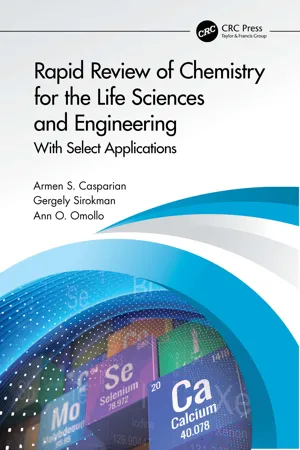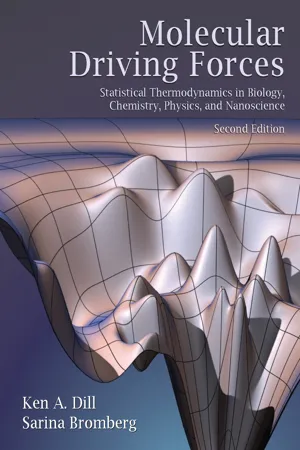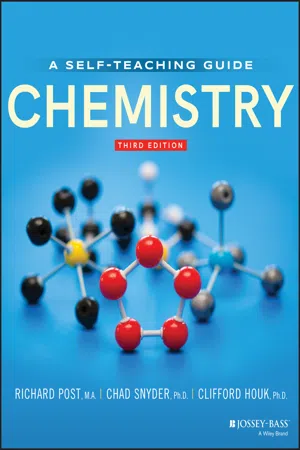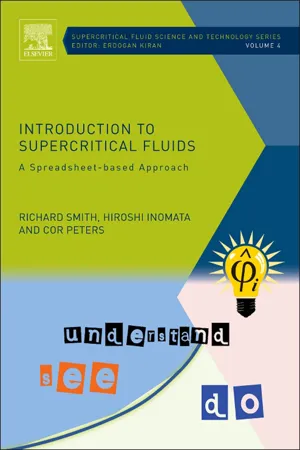Chemistry
Properties of Equilibrium Constant
The properties of equilibrium constant include being temperature-dependent, providing information about the extent of a chemical reaction at equilibrium, and being independent of initial concentrations. It is a ratio of the concentrations of products to reactants at equilibrium and is used to predict the direction of a reaction under different conditions.
Written by Perlego with AI-assistance
Related key terms
Related key terms
1 of 4
Related key terms
1 of 3
8 Key excerpts on "Properties of Equilibrium Constant"
- No longer available |Learn more
- Steven Boone, Drew H. Wolfe(Authors)
- 2011(Publication Date)
- Collins Reference(Publisher)
c . The equilibrium constant equals the product of the molar concentrations of the products, each raised to the power that corresponds to their coefficients in the balanced equation, divided by the product of the molar concentrations of the reactants, each raised to the power corresponding to their coefficients. Equilibria that have reactants and products in more than one phase are heterogeneous equilibria, and those in which all substances in one phase are homogeneous equilibria.If the value of the equilibrium constant is greater than one (K c > 1), the magnitude of the numerator (products) of the equilibrium expression is larger than that of those of the reactants. If the value of K c is less than one (K < 1), the equilibrium concentrations of the reactants are usually greater than those of the products.Equilibrium constants for gas-phase equilibria are often expressed in terms of their partial pressures. This is known as the K p equilibrium constant. The following equation shows the relationship of K p to K c .K p = K c (RT) ΔnEquilibrium constants are obtained by measuring the equilibrium concentrations or partial pressures of each component of an equilibrium mixture and substituting these values into the equilibrium expression.Before a system reaches equilibrium, the concentrations or partial pressures are expressed in terms of the reaction quotient, Q . The expression for Q is in the same form as that of K . The value of Q is used to determine the direction from which an equilibrium develops. Concentration, pressure, volume, and temperature changes affect the concentrations of the components of a chemical equilibrium. Their effects may be predicted by the application of Le Chatelier’s Principle, which states that equilibrium systems tend to absorb any changes that may occur in such a way to reduce the change and return to a state of equilibrium.Test Yourself1. Write the equilibrium expression for the following. - No longer available |Learn more
- Neil D. Jespersen, Pamela Kerrigan(Authors)
- 2023(Publication Date)
- Barrons Educational Services(Publisher)
PART 4Physical Chemistry
Passage contains an image
9
Chemical Equilibrium
Learning Objectives
In this chapter, you will learn:➔Chemical equilibrium ➔Dynamic equilibrium ➔Equilibrium expression ➔Law of mass action ➔Equilibrium constant➔Kc , kp , ka , kb , ks p , kf➔Manipulating the equilibrium expression ➔Thermodynamically favorable reactions ➔Extent of reaction➔Reaction quotient, Q➔Equilibrium calculations➔Determination of K➔Solubility product ➔Le Châtelier’s principleThe concept of a dynamic equilibrium is central to many aspects of chemistry. In a dynamic equilibrium, chemicals are reacting rapidly at the molecular scale, while their concentrations remain constant on the macroscopic scale.Figure 9.1 shows that a chemical reaction has two well-defined regions in time, and these regions are studied and measured in very different ways. When compounds are first mixed in a chemical reaction, they interact to form other compounds. During the reaction process, the concentrations of the reactants decrease and the concentrations of the products increase. While the concentrations are changing, the reaction is studied using the principles of chemical kinetics, which are reviewed in Chapter 10 . At some point in time, the concentrations of the reactants and products stop changing. Although reactions do not stop at the molecular level, at the macroscopic level the concentrations of compounds in a dynamic equilibrium remain constant. At this point, the compounds are in a dynamic chemical equilibrium with each other, and they are studied and described using the concepts of chemical equilibrium.Figure 9.1 - eBook - ePub
Rapid Review of Chemistry for the Life Sciences and Engineering
With Select Applications
- Armen S. Casparian, Gergely Sirokman, Ann Omollo(Authors)
- 2021(Publication Date)
- CRC Press(Publisher)
4 Chemical EquilibriumDOI: 10.1201/9781003092759-44.1 Basic Concept
Reaction equations describe substances, called reactants, which when put together react and produce other different substances, called products. It may appear as if only products remain after the reaction is finished. In reality, many reactions do not go to completion, even if the reactants are present in stoichiometric ratios or amounts. Rather, they reach a condition known as equilibrium, denoted by double, reversible arrows in the reaction equation. Equilibrium means that there is a balance between the reactant side and the product side, or simply between the reactants and the products, and that the reaction is reversible. The chemistry of many air pollutants falls and many bodily functions under the heading of equilibrium reactions. The equilibrium condition is dynamic, not static, allowing microscopic changes in reactant and product concentrations to take place, such that no net change in reactant or product concentrations occurs, provided that no external stresses are applied. At any given time, all species in the reaction equation—reactants and products—are present at equilibrium in varying amounts. The relationship among these varying amounts can be described by a mathematical formula known as the equilibrium constant expression or simply the equilibrium expression. The equilibrium expression is set equal to an equilibrium constant symbolized by Kc .An equilibrium reaction can be generally represented as follows:a A + b B ⇋ g G + h H(4.1)The Kc expression can then be expressed as follows:(4.2)K c=[ G ]g[ H ]h[ A ]a[ B ]bwhere a, b, g, and h represent the stoichiometric coefficients in the balanced reaction, and the brackets [ ] indicate molar concentrations. The simplest interpretation of Kc is that it is a measure of the extent to which a reaction goes toward completion, i.e., a reaction where the product side is favored. The meaning of Kc - eBook - ePub
Molecular Driving Forces
Statistical Thermodynamics in Biology, Chemistry, Physics, and Nanoscience
- Ken Dill, Sarina Bromberg(Authors)
- 2010(Publication Date)
- Garland Science(Publisher)
13 Chemical Equilibria Simple Chemical Equilibria Can Be Predicted from Atomic StructuresA major goal in chemistry is to predict the equilibria of chemical reactions, the relative amounts of the reactants and products, from their atomic masses, bond lengths, moments of inertia, and other structural properties. In this chapter, we focus on chemical equilibria in the gas phase, to illustrate the principles, since they are simpler than reactions in liquid phases. In Chapter 16 , we will consider solvation effects.The Condition for Chemical EquilibriumFirst consider the simplest equilibrium between two states, A and B:A→ KB .(13.1) Two-state equilibria include chemical isomerization, the folding of a biopolymer from an open to a compact state, the binding of a ligand to a surface or a molecule, the condensation of a vapor to a liquid, and the freezing of a liquid to a solid. The equilibrium constant K is the ratio of the numbers or concentrations of the two species at equilibrium. In this chapter, we suppose that you are able to measure the concentrations of reactants and products. Our goal is to predict those equilibria from the molecular structures of the products and reactants and from temperature and pressure.To make it unambiguous whether K is the ratio of the amount of A divided by the amount of B or B divided by A, the arrow in Equation (13.1) has a direction. It points to the final state from the initial state. The terms ‘initial’ and ‘final’ have no implication about time or kinetics. They imply only which is the numerator and which is the denominator in the equilibrium constant K. With the direction shown in Equation (13.1) , K is the ratio B/A. You can point the arrow in either direction. Once you choose the direction, the sign of every thermodynamic quantity is determined.The quantity that predicts chemical equilibria is the chemical potential. A chemical potential represents the tendency of a molecule or particle to move or convert or escape from the state it is in. For equilibria at fixed temperature and pressure, the appropriate extremum function is the Gibbs free energy: dG = −S dT + V dp + μA dNA + μB dNB , where NA and NB are the numbers of particles in the two states and μA and μB are their chemical potentials. At constant T and p - eBook - ePub
- Jeffrey Gaffney, Nancy Marley(Authors)
- 2017(Publication Date)
- Elsevier(Publisher)
Chapter 7Chemical Equilibrium
Abstract
This chapter reviews the principles of chemical equilibrium beginning with the concept that many chemical reactions are reversible. These reversible reactions achieve a dynamic equilibrium where the rate of the forward reaction equals the rate of the reverse reaction. This dynamic equilibrium is described by an equilibrium constant, which is determined from the concentrations of the reactants and products at equilibrium. The magnitude of the equilibrium constant is presented as measure of the extent that the forward and reverse reactions take place. Le Chatelier's principle is introduced and the changes in reaction conditions that can disturb a chemical equilibrium are reviewed. The response of the chemical reaction to these changes in reaction conditions is explained in detail. The reaction quotient is presented as a means of determining the direction the reaction is likely to proceed.Keywords
Reversible reactions; Dynamic equilibrium; Equilibrium constant; Partial pressures; Le Chatelier's principle; Exothermic; Endothermic; Reaction quotientOutline7.1Reversible Reactions7.2The Equilibrium Constant7.3Relationships Between Equilibrium Constants7.4Le Chatelier's Principle: Disturbing a Chemical Equilibrium7.5The Reaction QuotientImportant TermsStudy QuestionsProblems7.1 Reversible Reactions
The idea that a chemical reaction can be reversible was introduced by Claude Louis Berthollet in 1803 when he observed the formation of sodium carbonate crystals at the edge of a limestone salt lake in Egypt (Fig. 7.1 ). Since the salt lake was a landlocked body of water with a very high concentration of dissolved sodium chloride (> 3 g/L) and other minerals, he knew that the formation of these crystals must be a result of the following chemical reaction;Fig. 7.1 - eBook - ePub
Chemistry
Concepts and Problems, A Self-Teaching Guide
- Richard Post, Chad Snyder, Clifford C. Houk(Authors)
- 2020(Publication Date)
- Jossey-Bass(Publisher)
amount of any reactant or product, though both reactions still go on (forever). Since there are many such reactions that appear to go only partway to completion, their study is of major importance to the chemist.We will discuss several types of equilibrium in this chapter, along with their associated problems and concepts. You will use the concept of molarity you just learned in Chapter 11 to solve equilibrium problems.OBJECTIVES
After completing this chapter, you will be able to- recognize and apply or illustrate: equilibrium, equilibrium constant, equilibrant, equilibrium mixture, homogeneous equilibrium, heterogeneous equilibrium, Le Chatelier's Principle, common ion effect, ion product constant;
- define “reversible reaction” and write an example, and recognize at sight whether a chemical equation is written so as to indicate that the reaction is reversible;
- given a chemical equation, write the equilibrium constant expression;
- given the equilibrium constant expression, write the equation for the corresponding chemical reaction;
- given the equilibrium constant expression, state the units of Keq;
- predict whether changing the temperature of a system in equilibrium will shift the equilibrium to the right or to the left;
- state the effect on a system in chemical equilibrium of removing (or adding) a portion of one reactant (or product) and increasing (or decreasing) the total pressure on a system in equilibrium;
- given the balanced chemical equation for the ionization of a weak acid (or weak base), write the expression for the equilibrium constant;
- given the equilibrium constant expression and all the terms in the equation but one, solve for the unknown;
- given the data needed to calculate concentration terms for the equilibrium calculation, change the data into concentrations;
- given the degree of ionization (percentage ionization or fraction ionized) of a weak acid or weak base, calculate Keq, or given Keq
- eBook - ePub
Introduction to Supercritical Fluids
A Spreadsheet-based Approach
- Richard Smith, Hiroshi Inomata, Cor Peters(Authors)
- 2013(Publication Date)
- Elsevier Science(Publisher)
Chapter 9Chemical Equilibria and Reaction Kinetics
Richard Smith, Cor Peters and Hiroshi Inomata Logic will get you from A to B. Imagination will take you everywhere. Albert Einstein (1879–1955)Tip Box#1 Chapter objectives(1) to review key concepts in thermochemistry (2) to introduce methods for analyzing chemical equilibria (3) to show the effect of nonidealities on “real world” chemical equilibria (4) to introduce thermodynamic analysis of chemical reactors (5) to show how reaction kinetics are used to model reaction pathways9.1 Overview
Chemical equilibria gives one the composition of a reaction system in its most stable state, whereas reaction kinetics gives one the rate at which the chemical species are transformed from their initial state to a final state. Analysis of chemical equilibria helps one to understand the limits of a reaction according to its thermodynamics and the given reaction conditions. Analysis of reaction kinetics helps one to understand how long it will take to make the transformation in reality. Detailed development of chemical equilibria theory is given in many excellent undergraduate textbooks in chemical thermodynamics [CT1 –CT3] and chemical reactions [CT4] .With any type of chemical reaction or process, energy transfer occurs and this is the basis of thermochemistry. The energy transfer of a reaction is described by thermochemical equations, which are balanced stoichiometric equations for the reactant and product chemical compounds. Thermochemical equations are written in terms of the moles of each chemical compound, for example:(9.1)The a and b are stoichiometric coefficients that represent the moles of reactant chemical compounds A and B , respectively, required to form c moles of product chemical compound C . When changes in properties are calculated by treating Eq. (9.1) as a mathematical equation, by convention, the stoichiometric coefficients are positive (+) for products and negative (−) for reactants . Thus, the change in enthalpy of Eq. (9.1) - Mark Kernion, Joseph A. Mascetta(Authors)
- 2021(Publication Date)
- Barrons Educational Services(Publisher)
The following terms summarize all the concepts and ideas that were introduced in this chapter. You should be able to explain their meaning and how you would use them in chemistry. They appear in boldface type in this chapter to draw your attention to them. The boldface type also makes the terms easier for you to look up if you need to. You could also use a search engine on your computer to get a quick and expanded explanation of these terms, laws, and formulas.TERMS YOU SHOULD KNOW
acid ionization constant common ion effect enthalpy entropy equilibrium equilibrium constant free energy Gibbs Free Energy Equation Law of Mass Action Le Châtelier’s Principle Second Law of Thermodynamics solubility product constantReview Exercises
1 .For the reaction A + B ⇌ C + D, the equilibrium constant can be expressed as(A)(B)(C)(D)2 .The concentrations in an expression of the equilibrium constant are given in(A)mol/mL (B)g/L (C)gram-equivalents/L (D)mol/L3 .In the equilibrium expression for the reaction BaSO4 ⇌ Ba2+ + SO4 2− , Ksp is equal to(A)[Ba2+ ][SO4 2– ](B)(C)(D)4 .The Kw of water is equal to(A)1 × 10−7(B)1 × 10−17(C)1 × 10−14(D)1 × 10−15 .The pH of a solution that has a hydrogen ion concentration of 1 × 10−4 mol/L is(A)4 (B)−4 (C)10 (D)−106 .The pH of a solution that has a hydroxide ion concentration of 1 × 10−4 mol/L is(A)4 (B)−4 (C)10 (D)−107 .A small value for Keq , the equilibrium constant, indicates that(A)the concentration of the unionized molecules must be relatively small compared to the ion concentrations (B)the concentration of the ionized molecules must be larger than the ion concentrations
Index pages curate the most relevant extracts from our library of academic textbooks. They’ve been created using an in-house natural language model (NLM), each adding context and meaning to key research topics.
Explore more topic indexes
Explore more topic indexes
1 of 6
Explore more topic indexes
1 of 4

